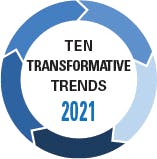Following the 2020 elections, the United States saw the election of a new president from the opposite party to that of the former president. At the same time, the Democrats have now won a new majority in the U.S. Senate, while retaining their majority in the U.S. House of Representatives. So with the White House, Senate, and House of Representatives controlled by one party, what might the impact be on healthcare policy development in 2021 and beyond?
The answer is not simple, for a number of reasons. First, all those interviewed for this article agree, the first few months of this year will have been dominated by issues around COVID-19 relief legislation. Indeed, as this article was going to press, President Joe Biden and the Democratic leaders in Congress were working on a COVID-19 relief package that was being prepared for a vote sometime in March. But after that? The biggest two factors in the federal healthcare policy landscape will revolve around potential modifications or enhancements to the Affordable Care Act (ACA), and around potential enhancements to value-based contracting, in the context of ongoing increases in total U.S. healthcare expenditures, which the Medicare program’s actuaries believe could explode from the current approximately $3.6 trillion a year to a potential $6 trillion a year within the next six years or so. In other words, the burning platform for change will provide a live flame motivating policy change in potentially key areas of healthcare payment and delivery.
Speaking in January, Blair Childs, senior vice president for public affairs at the Charlotte-based Premier Inc., predicted that the first six months of the year would focus almost entirely on COVID-19-related issues. But after that? It will be a different situation. Asked how the Centers for Medicare and Medicaid Services (CMS) might change under the new administration, Childs says, “I definitely think this will be much more of a reboot of what was in the ACA, which was about making a competitive marketplace move to value and APMs, [alternative payment models], but much more about bringing providers along. The Trump administration was very focused on the payer side. The latest Medicare Advantage call letter that got released [in January] was astounding, honestly, in terms of how it advantaged the payers. And I don’t want to sound anti-payer. I think this administration will focus more on bringing providers along.”
Indeed, Kerns says, “That’s why you’ll see more elements like those in NextGen [ACO program], where there’s going to be more prospective risk. The big open question is whether they want to make this mandatory for the whole country. And if they start to mandate all sorts of downside risk, there could be a lot of opposition to that. But if Medicare finds itself up against the wall, meaning that it has to cut spending growth, there are things like risk-based payments that would blunt the effect of certain reimbursement cuts or tax hikes. That’s why providers had better hope that risk-based contracting works, because if they can’t generate the savings that Medicare needs through value-based payments, the alternative will be major cuts to reimbursement, which no one will like.”
That leads also to the topic of encouraging a far higher percentage of provider organizations to take the plunge into two-sided risk. Is it in the cards for Congress and the Biden administration to push providers faster into two-sided risk, given the escalating costs of the overall U.S. healthcare system? Seth Edwards, vice president for strategy, innovation, and population health, at Premier Inc., puts it this way: “I think if you look at our current financial position for the Medicare Trust Fund, I’ve seen some really smart people suggest that we could move more rapidly except for some of the pandemic-related challenges. I think it will necessitate Congress and the Administration figuring out how to shore up the Medicare Trust Fund. And that would actually stimulate more providers to take on risk because of some of the actions that would have to occur.”
Indeed, Edwards says, “What I’m speculating is that, in order to shore up the Trust Fund, there will be likely payment reductions, regulatory movement around site neutrality, and other actions that would incentivize organizations to move into risk-based APMs. And I think we’re all seeing that. I work with about 75 health systems and clinically integrated networks (CINs) in our population health management collaborative, and many of them are already taking on two-sided risk in the MSSP [Medicare Shared Savings Program] and in MA. And we’re seeing a downstream impact of that in the commercial and employer space as well. That movement could catalyze other organizations to move into the MSSP, which has a determined path into two-sided risk. So I think we’ll see that happening more and more among all ACOs, including health systems.”
Indeed, Edwards says, “I think there could be an acceleration, not so much directly tied to risk, but more weighting of the base models in terms of the bonuses and discounts that might be applied. I do think that the public health emergency is creating a dynamic where economically or politically, it could benefit a discussion of the deficit and debt, and a large proportion of that expenditure is driven by healthcare.”
Beyond those issues, others hover on the horizon, including in the area of telehealth, say Darryl Drevna and Jamie Miller of the Alexandria, Va.-based AMGA (American Medical Group Association). Drevna, the association’s senior director of regulatory affairs, says that “MedPAC [the Medicare Payment Advisory Commission] is looking at how to modernize telehealth under the law.” And, among the issues the commission is looking at is the set of regulatory restrictions in place around geographic restrictions for providers of telehealth-based care delivery and others. Those restrictions were waived last March, but will have to be looked at once the public health emergency ends (currently set for the end of this calendar year). “That’s definitely on their agenda,” he says.
And, says Miller, the association’s senior director of government relations, “The discussion between committees in the House and the Senate, is around utilization.” And in the context of the potential change in the permanent regulations around telehealth, he says, there is a strong motivation there for legislators to help the healthcare system to save costs by making permanent all or most of the regulatory relaxations around telehealth ushered in by CMS last March.




